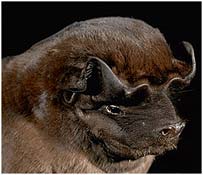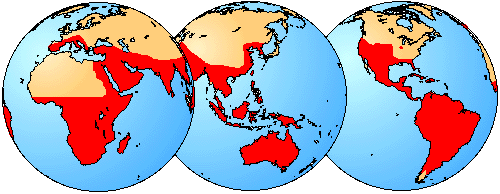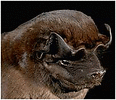Molossoidea
Nancy B. Simmons and Tenley Conway- Molossidae (Free-tailed Bats)
- Antrozoidae
Introduction
Molossoidea includes two families, Molossidae (12 genera and 80 species) and Antrozoidae (2 genera and 2 species). All molossoids are insectivores, and most (i.e., all molossids) are fast-flying ariel insectivorous. Antrozoids glean most of their prey from surfaces and may have a more generalized diet.
Characteristics
All Molossoidea share the following features:
- one upper incisor on each side of jaw.
- body of basihyal u-shaped.
- ribs with no anterior laminae.
- posterior laminae on ribs narrow, lamina width less than that of main body of rib.
- ventral process present, distal tip blunt or rounded.
- xiphisternum without keel.
Discussion of Phylogenetic Relationships
Until recently, Antrozoidea was placed in Vesperilionidae as either a seperate subfamily (e.g. Miller, 1897), a member of "Nyctophilinae" (e.g. Hill and Smith, 1984), or as a tribe within Vespertilioninae (e.g. Koopman, 1993, 1994). However, Simmons (1998) and Simmon and Geisler (1998) demonstrated that antrozoids are more closely related to molossids than to other vespertilionids. Simmon (1998) raised the group to family level as Antrozoidae and placed it in Molossoidea to reflect this relationship.
References
Hill, J.E., and J.D. Smith. 1984. Bats: a natural history. Austin: University of Texas Press.
Simmons, N. B. 1998. A reappraisal of interfamilial relationships of bats. In Bats: Phylogeny, Morphology, Echolocation and Conservation Biology. T.H. Kunz and P.A. Racey (eds.). Washington: Smithsonian Institution Press.
Simmons, N. B. & J. H. Geisler. 1998. Phylogenetic relationships of Icaronycteris, Archeonycteris, Hassianycteris, and Palaeochiropteryx to extant bat lineages, with comments on the evolution of echolocation and foraging strategies in microchiroptera. Bulletin of the American Museum of Natural History. 235:1-82.
Title Illustrations

| Scientific Name | Molossus rufus |
|---|---|
| Image Use |
 This media file is licensed under the Creative Commons Attribution-NonCommercial License - Version 3.0. This media file is licensed under the Creative Commons Attribution-NonCommercial License - Version 3.0.
|
| Copyright |
© 1998 Nancy B. Simmons

|
| Scientific Name | Molossus rufus |
|---|---|
| Image Use |
 This media file is licensed under the Creative Commons Attribution-NonCommercial License - Version 3.0. This media file is licensed under the Creative Commons Attribution-NonCommercial License - Version 3.0.
|
| Copyright |
© 1998 Nancy B. Simmons

|
About This Page
Nancy B. Simmons

American Musuem of Natural History, New York, New York, USA
Tenley Conway

University of Toronto at Mississauga, Ontario, Canada
Correspondence regarding this page should be directed to Nancy B. Simmons at
simmons@amnh.org
Page copyright © 1997 Nancy B. Simmons
 Page: Tree of Life
Molossoidea.
Authored by
Nancy B. Simmons and Tenley Conway.
The TEXT of this page is licensed under the
Creative Commons Attribution License - Version 3.0. Note that images and other media
featured on this page are each governed by their own license, and they may or may not be available
for reuse. Click on an image or a media link to access the media data window, which provides the
relevant licensing information. For the general terms and conditions of ToL material reuse and
redistribution, please see the Tree of Life Copyright
Policies.
Page: Tree of Life
Molossoidea.
Authored by
Nancy B. Simmons and Tenley Conway.
The TEXT of this page is licensed under the
Creative Commons Attribution License - Version 3.0. Note that images and other media
featured on this page are each governed by their own license, and they may or may not be available
for reuse. Click on an image or a media link to access the media data window, which provides the
relevant licensing information. For the general terms and conditions of ToL material reuse and
redistribution, please see the Tree of Life Copyright
Policies.
Citing this page:
Simmons, Nancy B. and Tenley Conway. 1997. Molossoidea. Version 01 January 1997 (under construction). http://tolweb.org/Molossoidea/16097/1997.01.01 in The Tree of Life Web Project, http://tolweb.org/











 Go to quick links
Go to quick search
Go to navigation for this section of the ToL site
Go to detailed links for the ToL site
Go to quick links
Go to quick search
Go to navigation for this section of the ToL site
Go to detailed links for the ToL site